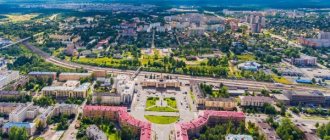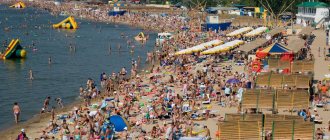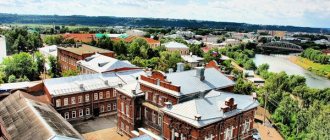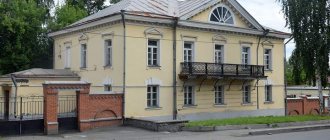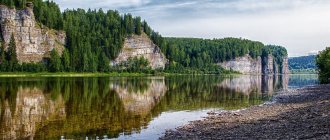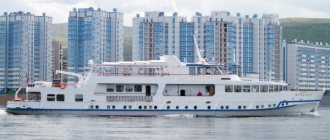Baltiysk is an unusual city - it is surrounded by water on three sides and is the westernmost city in Russia. The main attractions of Baltiysk are primarily the Baltic Sea, the Baltic Spit, the embankment and the Pillau citadel. The largest naval base, the Baltic Naval Base of the Baltic Fleet, is located here, so you can see many active military ships.
Where to go and what to see in Baltiysk, descriptions, photos and addresses of the most beautiful and interesting places.
A few facts about Baltiysk
- Until 1946, Baltiysk was German, like the entire Kaliningrad region, and was called Pillau.
- Pillau was founded in 1626.
- Until 1986, the city was closed, entry was carried out by passes.
- Baltiysk is a small city - the population is 33 thousand people.
- The city is divided by the Baltic Strait, connecting the Kaliningrad Bay with the Gdansk Bay and the Baltic Sea.
- Every year the city hosts a parade of ships of the Baltic Fleet.
- From Kaliningrad to Baltiysk it is about 43 km.
A little history
The first mention of a settlement called Pillau dates back to the 14th century. The name comes from the Prussian word “pilis” - fortress.
Port of Pillau
From the 16th to the 20th centuries, the city was alternately in the hands of Sweden, the Polish-Lithuanian Commonwealth and Prussia. The city has constantly developed due to its geographical location. It was an intermediate port on the way from Konigsberg to the Atlantic Ocean. Being a well-fortified fortress, Pillau served as reliable protection for passing ships.
During the Great Patriotic War, there were fierce battles in Pillau. It was from here that the civilian population of all East Prussia was evacuated by sea in panic from January 13 to April 25, 1945 - Operation Hannibal.
The Soviet army faced fierce German resistance in Pillau; it was the last stronghold of East Prussia. On April 25, 1945, the city fell under the pressure of the advancing Red Army. After the war, the territory of Pillau passed to the USSR.
Historical reference
The settlement of Pillau was first mentioned in the 14th century. This name has Prussian roots and means fortress in the translation of the word “pilis”. Starting from the 16th century, the city repeatedly came under the rule of the Polish-Lithuanian Commonwealth, Sweden, and Prussia. Due to its geographical features, its constant and active development took place.
The fact is that old Pillau was an intermediate port on the road from Konigsberg to the Atlantic. It acted as a protective, sometimes defensive fortress, protecting passing ships from ill-wishers.
With the onset of the Great Patriotic War, Baltiysk went through difficult times, when there were fierce battles between troops. The Prussian civilian population was evacuated from its territory by sea. This operation, called Operation Hannibal, took place in early 1945.
Approaching Pillau, the Soviet army encountered fierce resistance from the warring troops, which is not surprising, since the city was the last possible stronghold for Prussia. The fall of the village's defense from the actions of the Red Army occurred on April 25. With the onset of peacetime, the designated territory came under the rule of the USSR.
Sights of Baltiysk
View of the Baltic embankment from the Western Fort
The main attractions of Baltiysk are the Pillau fortress and the embankment. It is on the pedestrian embankment, called Morskoy Boulevard, that you can see the Baltic Spit, separated from the city by a strait. And also see the lighthouse and monuments to Peter I, the sailor’s wife and the Russian Empress Elizabeth. The extreme point of the embankment is the Northern Pier, the other point is the pier and the ferry station to the Baltic Spit.
Here, next to the Pillau fortress, there is the CSKA Sports and Fitness Complex (formerly “Priboy”), which has a water park, bowling alley, billiards, a cafe and an observation deck on the roof with panoramic views of the sea. The sports complex was built in 2008.
Pillau Citadel
Pillau Citadel
Entrance ticket cost: 100 rubles, schoolchildren, students, pensioners - 50 rubles, preschoolers - free. Excursion cost (1 hour): 200 rubles, entrance ticket is required, preschoolers are free. Tickets can be purchased at the Baltic Fleet Museum.
The main attraction of Baltiysk is the Pillau citadel. It is built in the shape of a pentagon, each side of which is 80 meters. The shape of the fortress in the form of a pentagonal star is clearly visible on the map. Each corner of the star is a bastion with its own name: König (King), Königin (Queen), Kronprinz (Crown Prince), Albrecht and Prussia.
The citadel is surrounded by a moat with water and is located on the shore of the strait separating Baltiysk and the Baltic Spit.
Construction of the fortress began in 1626 by order of the Swedish king Gustav II Adolf during the Polish-Swedish War. In 1697, Peter I studied bombardment, artillery and fortification art in the fortress.
The Pillau fortress was used by the Germans as a storage facility for artillery ammunition. After 1945, the fortress belonged to the Russian Ministry of Defense. In 1994, the Pillau fortress was classified as a historical and cultural monument; in 1999, part of the fortress was given to the Museum of the Baltic Fleet, a branch of the Central Naval Museum located in St. Petersburg. In 2022, the military completely transferred the citadel to the museum.
The Pillau Citadel is another proposed site that may house the lost, famous Amber Room, stolen by the Germans from Pushkin in 1941, and other valuables taken from the USSR.
“From Pillau to Baltiysk”: the history of the westernmost city in Russia (photo)
Baltiysk is strongly associated among Kaliningrad residents with a military base, wonderful wide beaches and a long pier. Recently opened to “outside” eyes, the seaside city is getting used to its attractiveness and does not hesitate to tell thousands of stories of its existence.
It so happened that many kings and even nature fought for Pillau (that’s what Baltiysk was called until 1945). The sea contributed in every possible way to the emergence and development of the city. Unfortunately, as in many cities of the Kaliningrad region, mostly only stories remain of the previous architecture. But the narrow cobbled streets, monuments and embankments remember everyone who once tried to become the master of this city.
Walking around Baltiysk listening to the stories of the guide, every now and then I wanted to close my eyes and imagine Pillau at all times - from the appearance of the first adventurers in pursuit of amber and ending with the construction of the Northern Pier, which to this day welcomes guests for long walks at sunset. However, first things first.
Mermaids, sturgeon and storm
It is known that Baltiysk was formed from five independent villages. The first mention of a settlement in this area dates back to the 13th century. This village was called Wogram and occupied an area of 17 hectares. It was inhabited by knights and settlers from Europe, who liked the sea rich in fish and forests full of spoils. However, many were also attracted by the desire to get rich - the sand by the sea was “stirred” with expensive amber.
As already mentioned, the struggle for this territory was undertaken not only by people, but also by the elements. Natural phenomena that are abnormal in our understanding happened in this area quite often. Among them are the Northern Lights, a meteorite fall, and snow in June. As for the wind, it played a decisive role in the life of these places. Thus, the first destructive storm hit Wogram in 1690, and the surviving people were forced to move to other settlements.
As for the village with a name similar to Pillau (Pill, Pile), it appeared 166 years later than the emergence of the village of Wogram. Translated from Prussian it meant “mountain”, “castle”, “fortress”. But there is an ancient Prussian legend that the name of the city was given by the mermaid Pilla, who came ashore to dry her hair. It’s up to the reader to believe it or not, but, in my opinion, this beginning of the story for a wonderful seaside town sounds quite natural.
All residents of this village were in one way or another involved in catching and processing sturgeon. The most important building of the village was the Sturgeon Hut on the hill; an Orthodox church now stands in its place. It is worth noting that Baltiysk owes its development to this fish. The first settlement appeared around this hut, and the building itself was something like a treasury - in addition to fish, collected amber was brought here. Back then, up to a thousand sturgeon were caught per year, and its processing was a state monopoly. Sturgeon masters and even their assistants were the most influential residents of the city. However, the significance of this fish did not pass by - its image later began to appear on the coat of arms of Pillau, and now on the coat of arms of Baltiysk. It will most likely come as a surprise to many that such rare fish were once found in our sea. The fact is that the sturgeon loves clean water, and when ships switched to heavy fuel oil, it practically disappeared from the Baltic Sea.
It is unknown how the fate of this territory would have developed if in 1510 a severe storm had not come from the sea, during which a strait was formed, separating the current Baltic Spit from the land. The echoes of this storm were also felt by the residents of Königsberg, many of whom were unable to sleep due to the raging Pregolya. Later, the residents of Pillau began to call the strait “given by God,” because with its emergence, the life of the new settlement changed dramatically for the better.
New Pillau, the Swedes and the first stones of the fortress
After the storm, the residents of Pillau came out of hiding and discovered that their city had taken on a different shape: part of the land had separated, and a strait had formed. After this day, life was no longer the same - people settled on the current spit, and the strait became navigable, bringing colossal development to the economy and history of the city. It was from this moment that Pillau was divided into Old and New.
The strait called Frisch Gaff provided tremendous changes, income and development of the city. Within ten years, braziers with coal for lighting, primitive lanterns, a beer hall and a bakery appeared in Pillau. The city also began to strengthen militarily - a blockhouse appeared, which was later transferred to customs, as well as earthen fortifications and ditches. Customs duties paid by passing ships and the successful trade in sturgeon brought considerable income and ensured the life of the settlement.
Over the course of a century, Pillau became a tasty morsel for conquerors, and during the Prussian-Swedish War in 1623, King Gustav II Adolf of Sweden landed in the peaceful city. Three hours later, his troops completely occupied Pillau, and the king declared that “he needs this bad sandy site temporarily.” Soon he instructed his subordinates to build a fortress and went on a campaign. Four thousand people were gathered for its construction, but a year later the plague claimed a huge number of lives. The construction of the Swedish fortress, known to us, continued only in the year of the king’s death, in 1632. The Dutch engineer Matnal Ventu began the construction of a five-pointed building, which three years later was sold to Prussia in honor of reconciliation. The history and architectural features of this fortress are very interesting, and we will definitely return to them next time.
Frederick William the Great, city status and first Russian traces
A year after the conclusion of a peace agreement between the Prussians and the Swedes, Brandenburg troops entered Pillau. Their life in this territory was not sweet - everything depended on the amount of money received from the sale of amber and customs duties. In winter, navigation almost ceased, and life became almost unbearable. However, this did not kill the morale of the soldiers, and they continued building the fortress.
In 1657, the Polish-Swedish war broke out again, and Pillau was again in danger. For defense, a flotilla of three ships was assembled, which became the basis of the future Prussian fleet. The ships were commanded by the governor of Pillau, Colonel Pierre de la Cava. Three years later, Poland and Sweden again concluded a peace treaty, which returned calm times to the city.
At this time, Frederick William the Great came to power in Pillau, who became one of the key figures in the history of the city. During his reign, residents received the right to trade with the owners of ship cargo, a mill and a small wooden lighthouse were built. Not far from the lighthouse, the first hotel and the first bastion for protection from the storm appeared. By 1660, about 300 people lived in Pillau.
In 1697, three years before the five-pointed fortress was completed, Peter I arrived in Pillau as part of the Great Embassy. His retinue numbered four thousand people. In order to better understand the architecture and strengthen ties, the Russian Tsar visited Pillau twice more - in 1711 and 1716. The Russian ruler enjoyed great respect among the Prussians. King Frederick William I even presented him with a 55 square meter Amber Cabinet and the Amber Room as a gift. The legends about this room are well known to Kaliningrad residents, because the next refuge for treasures after St. Petersburg was Koenigsberg. The further fate of the Amber Room is unknown - no matter how much they search for it. In response to the generous gift, Peter “presented” the Prussians with 55 Russian giants for the royal guard. On the occasion of the 300th anniversary of the Baltic Fleet, a monument to the last Russian Tsar was erected in the city.
All this time, the rapidly developing and attractive settlement for foreigners did not have the status of a city. Pillau acquired it only in 1725. Then the coat of arms known to the Baltic people was introduced with the image of a sturgeon in a golden crown.
The next Russian trace in Pillau was left during the Seven Years' War, in 1758, when the army of Elizabeth I occupied Prussian territories. When the troops of the Russian Empress came ashore at Pillau, many townspeople fled to Königsberg. However, those who remained were not subjected to hardship or torture. On the contrary, the entire population was declared free in faith, trade and the press. The students continued their studies, and the teachers enjoyed special respect from the Russians. Even Prussian peasants engaged in construction were allowed to go home to harvest the harvest, which was used to support them. In turn, the Russian troops ate bread brought from their native fields.
Sooner or later, the Prussians still had to pacify their patriotic feelings - on January 24, the birthday of King Frederick the Great, they all took an oath of allegiance to Russia. However, this was a kind of privilege, because in Russia only nobles had the right to swear allegiance. The great philosopher Immanuel Kant also bowed his knee to Elizabeth.
This state of affairs, for obvious reasons, did not suit the Prussian king, and from the first day of the invasion of his lands he began to hatch a plan of retribution. One of the key roles in this conspiracy was played by the postmaster of Pillau, Ludwig Wagner, who transferred information and money to the king. For several years, the Prussians developed a scheme for the liberation of Pillau from the “usurpers,” but their plans were unsuccessful. The conspiracy was discovered, and its participants, Wagner and other assistants of the king, were exiled to Siberia.
During the reign of Elizabeth in Prussia, the “Russian Dam”, today better known as the Russian Embankment, and an Orthodox Church were built in Pillau. Russian funds were invested in the development of the city, and the Empress's army worked to improve its lands and treat the local population with respect.
The French, the lighthouse, the North Pier and the decline of Pillau
During the Franco-Prussian War in the early 19th century, the French entered Pillau for the first time. Then the army failed to take the fortress, and a month later the states had already concluded the Peace of Tilsit. The second attempt to settle in the seaside city came in 1812. The French who occupied the city did not remain in it for long - in the same year they retreated under the pressure of Russian soldiers.
Soon after these events, in 1816, a new lighthouse was built in Pillau, which to this day is one of the symbols of the city. Its height is more than 30 meters. The author of the building is unknown - different sources suggest different versions. The light, indicating the way for sailors, is visible for 16 nautical miles (about 30 kilometers).
In the 19th century, another attraction appeared in Pillau, which today is the hallmark of Baltiysk. The westernmost point of Russia, the Northern Pier, was built over forty years, from 1840 to 1883. Undertaking such an expensive “project” was necessary to curb sea flows and prevent the strait from shallowing. The pier really fulfilled its function - the depth of the strait increased from three to nine meters, and Pillau did not lose his customs privileges.
In the forties of the 19th century, Pillau began to experience economic difficulties. Trade worsened, and more and more people were left without work. However, work on the development of the city went on continuously - in 1865, Pillau and Königsberg were connected by railway, which greatly facilitated the delivery of goods. Throughout the 19th century and until 1945, planned landscaping was carried out in the city - trees were planted, wide walking roads were built.
In 1817, the first printing house opened in Pillau, thanks to which it was possible to preserve information about the ships that called at the city port. Later, in 1848, the first local newspaper “Ogni Pillau” appeared in the future Baltiysk. The constant work of the residents of Pillau and their strong spirit made it possible to bring the city out of the crisis - in the second half of the 19th century it became the most profitable in East Prussia. For relaxation and to “heal their nerves,” the “cream” of the creative elite came to this city. In 1869, competitions of the Königsberg yacht club "Rhil" were first organized here, which have been held annually in the summer since 1880. With the beginning of perestroika, this tradition was resumed, and the regatta, as a rule, is held on Navy Day.
Despite the success of the townspeople, progress did its insidious work - in 1901 the Königsberg Canal was opened, which allowed ships to enter the city without going through Pillau. This event gradually began to lead the lives of the townspeople into decline.
Since then, the city has begun trying to take it “to another level.” The authorities intended to “repurpose” Pillau into a tourist attraction, and for this it needed changes. In addition, industrial development began at this time. “In 1914, the First World War began. The Russian fleet mined the sea coast. According to O. Schlicht, the mines were of very good quality, but poorly installed. There was real panic when they started washing up on the coast. Not only ships and fishing boats at sea were blown up, but also people on the coast. Specialists walked along the shore and neutralized mines. When Russian troops almost approached Königsberg, many fled from the city. The residents were greatly impressed by the sight of a convoy of ships escorted by an airship,” writes Lydia Dovydenko in her book “Secrets of Pillau.”
Hard times have come for the residents of the city: food is rationed, the main food product is rutabaga. People were obliged to give up metal, and the state bought up valuables. After the end of the war, Pillau became the only way to get from East Prussia to Germany without Polish control. Hundreds of ships carrying those wishing to come to or leave Prussia passed through the sea gates of the city. In 1921, Pillau became a closed city and was declared a base for the German fleet, which, however, did not interfere with the further development of the city's infrastructure. So, in 1927, water supply appeared in the city, and the first water tower has survived to this day. And the wastewater treatment plant built that same year remained virtually untouched and is used by the Baltic people today. In addition, in the thirties, hotels, boarding houses and small cafes began to be built on a large scale in Pillau, and in 1934 the construction of an airfield began. Tourists continued to arrive in the city, and transport links to Königsberg and around the city were established.
The Second World War interrupted all beginnings and construction and the city again plunged into poverty. From the memoirs of Erwin Friedrich Kafke, who worked in the Pillau administration.
“The sturgeon above the town hall sparkled with a joyful, hospitable crown. He saw endless misery, death and destitution as a stream of East Prussian refugees poured into the city on January 18, 1945, hurrying to the port.”
Despite the entry of Soviet troops into the city, about 250 indigenous residents chose to remain in Pillau. However, in 1948 they were forcibly deported. On November 27, 1946, Pillau was renamed Baltiysk.
Memories of a Pillau resident
People from Pillau now mainly live in the German town of Eckenförde. Every year they gather at the monument to the Great Elector, built in 1913 in their native Pillau. He accidentally survived the war and was found in Hamburg, from where he was taken to the new place of residence of these people.
Some of them were able to visit their homeland and tell today's Baltic people what it was like to live in a wonderful seaside city. Lidia Dovydenko kindly provided Kaliningrad.Ru journalists with a story from one of them.
From the memoirs of Joachim Ruge, who lives with his wife Vera near Dresden:
“We loved to gather around the big tiled stove, especially in the fall and winter and when the power went out due to a storm. My father was often absent from home because he worked as a pilot and escorted visiting ships along the sea canal to Königsberg or Elbing (Elblag). And mom was always with us. We really enjoyed spending time at dusk, saving electricity, sitting near our stove. We sang songs, for example, “Do you know how many stars are there in the sky,” ate apple pie, or mom talked about her childhood. Her parents' house was so tiny that there was barely room for a table with chairs around it. But that didn’t stop him from being sweet and cozy.”
“On April 4, 1937, I was enrolled in first grade. According to the old tradition, I received a gift. There was such a cardboard package in the form of a long cone, about 80 centimeters long, which was filled with sweets and small items needed at school. The public school I went to was located on modern Golovko Street; this building has not survived. For physical education classes we walked through the schoolyard to the sports hall, which belonged to the boys' high school (now the building of the sailors' club), where I began to study after Easter 1941. My journey to school was very short, unlike my older brother and sister, who studied in Pillau-2 (today it is Lyceum No. 1). English was the first foreign language, and from the 3rd grade I started learning Latin.”
“Today the center of Baltiysk is Pillau-2, but in my time the main life of the city was concentrated in Pillau-1. It seems like a small space - but there were 21 streets and two squares. The houses were mostly one-story. The central square (today the final stop for minibuses on Kronstadt) had a triangular shape. On it stood the town hall with a turret, on the spire of which a metal sturgeon spun and showed the direction of the wind. There was also a pharmacy, an ice cream parlor, a Kaiser cafe-shop, numerous shopping shops and our favorite cinema. There was a fountain in the center of the square. The most important buildings were the lighthouse and pilot tower, the monument to the great elector (on the site of the monument to Peter I), the magnificent post office building (not preserved), the Golden Anchor, the courthouse (BF museum), the reformist church (today Orthodox), the old fortress and barracks (base headquarters building). Among cafes and canteens, the townspeople’s favorite place was the Ilske-Falle cafe (not preserved). It was decorated in a nautical style, with paintings on the walls related to the theme of the sea and marine life.”
“Behind the treatment plant, between the fortress and the canal, there was a meadow, and there was a so-called bleaching plant. Here housewives dried white bed linen, white towels and tablecloths in the sun. In winter, in this place, one resident of Pillau (I don’t remember his name) filled a skating rink here, and we skated there as much as we wanted, for 10 pfennigs. The skating rink was very popular.”
“During the war, the famous liner Robert Ley stood in Pillau just opposite the monument to the Elector. His cabins became apartments for many submarine sailors. We, the children of pilots, completely explored and studied this ship, learned Morse code, and put on gas masks. Once I was splashed with acid, and holes appeared in the place of these splashes. It was a disaster, and my mother spent a long time sewing on many patches, since I had no other suit. In August 1944, British aircraft began bombing Koenigsberg. My brother and I climbed into the attic and from the window we saw the blood-red sky in the east. It was Koenigsberg that was burning."
Kaliningrad.Ru thanks Lidia Dovydenko, a scientist and journalist who has already republished her book “The Secrets of Pillau” three times, for her assistance in preparing the material. The editors also express gratitude to Fedor Muntyan for the tour and old photographs of the city.
Interesting facts about the city
In 1585, the inhabitants of Pillau observed the Northern Lights.
In 1642, a decree was issued in Pillau providing for heavy fines for women who were seen in quarrels and gossip.
The famous composer Richard Wagner fled from creditors to London through Pillau.
In 1769, a meteorite fell on the territory of Pillau.
The first train with passengers from Königsberg reached Pillau in 78 minutes.
In June 1871, snow fell in Pillau.
Text - Elizaveta Shafer, photo - Kirill Novikov
The author's opinion may not coincide with the position of the editors of Kaliningrad.Ru
Museum of the Baltic Fleet
Website : navalmuseum.ru. Address: st. Kronstadtskaya, 1. Opening hours: from 10.00 to 18.00 - Wednesday-Sunday. Ticket price: 200 rubles, schoolchildren, students, pensioners - 100 rubles, free for preschoolers.
The Baltic Fleet Museum was opened in 1959. Since then, he has changed his location several times. Today it is located in the building where the court of the city of Pillau was located before the war. The building is interesting for its architecture: pseudo-Gothic style, built in 1903.
But the main asset of the museum is its exhibitions. Here are models of ships, weapons, ammunition, documents, awards for sailors from the First and Second World Wars, and portraits of Baltic heroes. The museum preserves the history of the Baltic Fleet, including the development of naval aviation, the submarine fleet, as well as the history of the city of Pillau-Baltiysk.
Economy and population of Baltiysk
The life of modern Baltiysk is closely connected with the military base and seaport. Most of the city's residents are, one way or another, involved in servicing these two facilities.
As of 2022, just over 33 thousand people live in Baltiysk. The average age of its residents is 36 years. Despite the low birth rate, the city's population is growing due to the influx of migrants from the CIS countries. Compared to other settlements in the Kaliningrad region, Baltiysk is a fairly “advanced” city. One fact eloquently testifies to this. In 2009, residents of one of the multi-storey buildings, in which the elevator did not work for many years, brought this case all the way to the Strasbourg court!
Key sectors of the local economy are the ship repair and food industries. Tourism has been actively developing over the past ten years. The largest industrial enterprise in Baltiysk is ship repair plant No. 33, which serves both military and civilian ships (including foreign ones). An oil transshipment company also operates in the city.
The seaport has played a vital role in the development of the city since its foundation in the 16th century. It developed especially rapidly in the 19th century. Today, work is actively underway to modernize it. Every year at least one million tons of various cargo passes through the seaport of Baltiysk.
Naval Cathedral
Address: st. Admirala Kuznetsov, 3
The Cathedral of St. George's Naval Cathedral is located in the church building next to the Baltic Fleet Museum. The church was built in 1866 in the neo-Gothic style from red burnt brick. In Soviet times, a sailor's club was located here, then military warehouses.
In May 1991, the building was transferred to the Russian Orthodox Church, and now there is a functioning Orthodox church in the former church, which is common in the Kaliningrad region.
Walk through amazing places
In 1959, a museum entirely dedicated to the Baltic Fleet began operating and changed its location several times. It currently resides in a building that was occupied by the city court before the war. The house is made in pseudo-Gothic style. The main asset of the institution is considered to be its unusual exhibitions, containing:
- ammunition;
- models of various ships;
- documentation;
- weapons;
- awards given to sailors for their services in the First and Second World Wars;
- portraits of Baltic heroes.
The museum conveys in detail the history of the formation and development of the city, tells interesting facts about the submarine fleet, as well as naval aviation of Baltiysk.
Excursion routes always pass through St. George's Cathedral. It is located in the church building, adjacent to the museum. The neo-Gothic style church, in turn, was created in 1866, for which burnt red brick was used. Under Soviet rule, a sailor's club functioned in the building, and later military warehouses were set up here. The house came into the hands of the Russian Orthodox Church in 1991. Currently, the church has been converted into an Orthodox church, which is typical for the border zone of Russia.
The real pride of Baltiysk in the Kaliningrad region is the lighthouse, which is distinguished by its unique construction technology. Directly at the entrance to the Baltic Strait, concrete piles connected to each other by strong chains are fixed underwater in the bottom. Huge wild stones are laid between the pillars. Together, this structure forms the basis for the lighthouse. It is made in the shape of a truncated cone, which rises to a height of 31 m.
Previously, lighting was provided by burning vegetable oil, later kerosene began to be used. Currently, electricity is used for this purpose. In clear weather, the fire can be seen at a distance of 30 km, which is equal to 16 nautical miles.
Monument to Empress Elizabeth
In 2004, a monument to the Russian Empress Elizaveta Petrovna was erected in Baltiysk, sculptor Georgy Frangulyan. In honor of the events of the Seven Years' War, when East Prussia became Russian (1758-1762), and its entire population swore allegiance to Elizabeth Petrovna.
The weight of the bronze monument is 12 tons, height is 14 meters. The Empress sits on a horse in the uniform of a colonel of the Preobrazhensky Life Guards Regiment. The monument is installed on a powerful pedestal on the embankment.
Morskoy Boulevard
There are many attractions on Morskoy Boulevard. These include sculptures and architectural buildings.
Monument to Peter the Great . The monument is considered one of the calling cards of the city. Peter himself came to the Pillau fortress several times to see how this fortification structure was constructed.
The lighthouse is located next to the monument to Peter the Great. It is this lighthouse that ships approaching Kaliningrad are guided by.
The Baltic lighthouse is considered the westernmost in Russia. Its height is a little more than 33 meters above sea level. And the light is visible at a distance of 16 nautical miles.
Interesting Facts
The lighthouse was built in 1741. At first, the light beam was created by burning vegetable oil. In 1874 it was replaced with kerosene. Gas lamps were then used. And in 1913, the lighthouse switched to electric lighting.
During World War II, the building was damaged. However, restoration work began almost immediately, since after the war Baltiysk became a naval base of the USSR.
During the restoration of the lighthouse after the war, a temporary fire burned on it for several years. In 1953, construction of a new structure was completed. The Baltic lighthouse was assigned first class, and the operating period became 12 seconds. That is three seconds of darkness and nine seconds of light. It has a unique Fresnel lens made in France.
Previously, it was possible to climb the lighthouse. However, in 2010 the entrance was closed.
There is a sign like this at the entrance to the lighthouse. On June 8, 2013, the lighthouse was included in the atlas of the “Maritime Heritage of Russia”. In the atlas, the Baltic Lighthouse is listed as number one due to its geographical location.
There is another sign nailed to the building where the lighthouse is located. And so he puzzled me. What do these numbers in the circle mean? If you know, please share in the comments.
The pilot tower rises near the lighthouse. It looks like two half-cylinders connected to each other. The raid service post of the Baltic Naval Base is located here. Modern surveillance equipment is located on eight floors of the tower. They make it possible to determine the deviation of ships from the axis of the fairway with an accuracy of five meters.
About pilots
We have an essay on the project about the only Pilot Museum in the world. It is located in Arkhangelsk, on one of the islands in the Northern Dvina delta.
Now let's walk along Morskoy Boulevard along the sea.
Concrete tower with range finder. Locals call it "Dragon's Head". The tower was built in 1945 and served as an observation post for the Coast Guard. It was used by a railway artillery battery to adjust fire.
The radar tower is clearly visible from the road . I think it is operational and located on the territory of the Baltiysk naval base.
And here is the monument “The Sailor’s Wife” . This sculpture was moved to the shore of the Kaliningrad Bay from the city park. A woman with a child on her shoulder peers into the distance. She is waiting for her husband, who will definitely return from a long voyage.
The Sailor's Wife reminds me of another monument. It is located in Murmansk and is called “Waiting”. I talked about it in the essay “Monuments of Murmansk”.
Tetrapods. These are huge concrete blocks in the shape of a cone with four arms. They are designed to fence and protect the coastline.
The monument to Elizaveta Petrovna rises at the very end of Morskoy Boulevard. The Empress is depicted riding a horse in the uniform of a colonel of the Preobrazhensky Life Guards Regiment. Does everyone remember that this was one of the oldest guards regiments of the Russian Empire?
The height of the equestrian statue is 14 meters. If you get very close, the monument seems simply huge. Residents of Baltiysk have already dubbed it the local “Statue of Liberty”: now it is Elizabeth, and not the “Sailor’s Wife,” who greets all ships coming to Baltiysk.
You can climb to the monument by stairs. As you can see, the pedestal is made in the form of a fortification.
From the height there is a breathtaking view of the pier and sand dunes.
Sculpture of a sailor's wife
If we talk about sculptural monuments, the most touching and symbolic is the sculpture of a woman with a child, “The Sailor’s Wife.” Once it was located in a city park, now it is on the shore of the Kaliningrad Bay.
The sculpture symbolizes the value of the family hearth, the importance of which increases greatly in the conditions of a long separation of sailors from their home base. This landmark of Baltiysk immediately after its installation fell in love with the city residents.
Lighthouse
The red and white lighthouse is a symbol and landmark of Baltiysk. The technology of its construction is interesting. At the entrance to the Baltic Strait, concrete piles are driven into the seabed and connected to each other by chains. Large field stones were placed in the spaces between the piles. This is how the foundation of the lighthouse is formed.
The Baltiysk lighthouse has the shape of a truncated cone 31.4 meters high. Initially, the glow was achieved by burning vegetable oil, then - kerosene. Nowadays electricity is used for this purpose. The visibility range of the fire in clear weather reaches 16 nautical miles (about 30 kilometers).
Monument to Peter I
Address: Morskoy Boulevard
In 1998, the Baltic Fleet celebrated its three hundredth anniversary. By this date, a monument to Peter I by I. Minin and V. Bartenev was erected in Baltiysk. The height of the monument with a pedestal is 6.4 meters, weight is 2.5 tons. Emperor Peter is depicted in full growth, in his right hand he holds a telescope, with his left he leans on a scroll lying on a music stand.
It is noteworthy that the Russian emperor visited Pillau three times, which Peter liked for some reason, and he gave this city the name “little Amsterdam”.
torpedo boat
Address: between St. George's Naval Cathedral and Baltic Glory Square.
The Torpedo Boat monument was erected in 1973 in honor of the sailors of the First Red Banner Torpedo Boat Brigade. It is a real combat boat "Komsomolets" model 1944 with hull number 36 on the pedestal.
Lenin Street
In any city of Soviet times, one of the main streets always bore the name of Lenin. Of course, Baltiysk was no exception.
Previously, it was Gvardeysky Avenue, which was later renamed Lenin Street. It represents the main axis of the city, running parallel to the railway. At the very beginning of the street there is a railway station . And there is also the final stop for buses and minibuses going to Kaliningrad.
Lenin Street is quite long. I only had half an hour to walk around it. But during these half an hour I saw a lot of interesting things.
Here is the lyceum building. Look, even in Baltiysk the Skolkovo resource is being tested!
At the intersection of Lenin and Chekhov streets there is a former pastor's house . If I'm not mistaken, it now has an active Catholic parish.
And this is the library building of the officers' house. She bears the name Valentin Pikul. The writer himself has visited Baltiysk several times.
Old German houses give Baltiysk a special charm.
The Chapel of Dmitry Donskoy is visible behind the trees . It was installed in memory of soldiers who died in local conflicts. The chapel was built on the model of the “Millennium of Christianity in Rus'” chapel, which is located in the Danilovsky Monastery in Moscow.
Lenin Street also has its own street art - where would we be without it?
I can’t understand why my eye was drawn to the house in the photo on the right. Entrance staircase without railings. TV dish in front of the attic exit. Flag holder next to the door. And plastic windows. Here it is, a meeting of the past with the present!
Do you see how many interesting things there are on one of the main streets of Baltiysk?
Infantry barracks
Address: Lenin Avenue, building 1
The Baltiysk infantry barracks were built in 1904 to house the military garrison of Pillau. The headquarters, Northern and Southern barracks, a 30-meter-high water tower, warehouses and other outbuildings were located here. Before the First World War, an artillery barracks was built. After the war, the buildings first housed warehouses, and then various units of the German army.
During World War II, there was a submarine school here, where the elite troops of the German Navy were trained. After the war, the barracks were heavily damaged and restored in the 50s of the last century.
International Memorial Cemetery
Victims of the Second World War are buried in the cemetery, mainly in the first months (January-April) of 1945, when fighting took place in East Prussia. The burials are carried out by the German People's Union for the Care of War Graves in accordance with the German-Russian Agreement of December 16, 1992.
Construction of the memorial burial ground in Baltiysk began in 1996, and it was completed in 2000. Previously, the territory of military Baltiysk was closed to everyone, which made it impossible for the German organization to work here.
The cemetery contains not only the graves of German soldiers and officers, but also civilians, including 204 refugees from the ship Wilhelm Gustloff, sunk by a Soviet submarine under the command of Alexander Marinesko on January 30, 1945. Citizens of the USSR and other countries who died in the war are also buried here.
At the cemetery there is a monument in the form of three crosses: one Orthodox, two Latin. The crosses on the graves are grouped in groups of three throughout the memorial. There are memorial plaques with the names of identified people, their dates of birth and death.
Pages of history
Before getting acquainted with modern Baltiysk, I suggest looking through the pages of its history.
According to sources, the German city of Pillau arose as a result of the merger of several villages. The first documented mention of it dates back to 1430. The inhabitants of Pillau were then engaged in fishing.
In 1497, a port between the sea and the freshwater bay. In 1501, after a strong storm, the strait became navigable and a harbor . After this, a system of shelters, fortifications and port warehouses begins to be built in Pillau.
During the Thirty Years' War, the harbor was occupied by the Swedes after their victory over the Polish-Lithuanian Commonwealth. They build a star-shaped fort at Pillau.
In 1679, the creation of a merchant and military fleet . It is no coincidence that Peter the Great came here as part of the Great Embassy to study the experience of building fortresses and ships.
In 1725, Pillau acquired the status of a city . As a result of the Seven Years' War, it was occupied by Russian troops. In June 1807, Pillau was stormed by Napoleon, but a temporary truce was reached a couple of months later. In 1812, Napoleon was forced to retreat from Pillau.
The city, located on the Baltic Spit, becomes one of the outposts of Prussia . After the First World War, under the terms of the Treaty of Versailles, East Prussia was cut off from Germany. It was then that the role of Pillau as a trading port increased. In 1921, the city became a base for the German fleet and free access to the city was closed.
On April 25, 1945, Soviet troops under the command of Colonel General Galitsky captured Pillau by storm. The castle was completely destroyed, but the fortress survived.
On November 27, 1946, by decree of the Presidium of the Supreme Soviet of the RSFSR, the city of Pillau, Primorsky District, was renamed the city of Baltiysk.
In the post-war years, the city was closed to visitors because it was a border zone. It was possible to get there only by invitation, which was issued by the military commandant's office.
In 2000, it was here that the main Russian naval parade took place. And in 2003, the city already celebrated the 300th anniversary of the Baltic Fleet.
______________________________
Do you feel how much this city has gone through?
Now let's walk around Baltiysk. I invite you to start our walk around the city from Morskoy Boulevard.
City Park named after Golovko
Residents of Baltiysk love to relax in the city park named after Admiral A.G. Golovko, located on the shore of the Gulf of Gdansk. The park was laid out at the beginning of the 19th century as protection from sand and was first called Primorsky.
Here lovers retire in the shade of trees. There is a summer stage where local and visiting performers perform. There are cafes and ice cream is sold.
In the nineties of the last century, the park fell into disrepair. But in subsequent years, restoration work was carried out by military builders. and now he has again begun to delight the townspeople.
Baltic Naval Base
The Baltic naval base is the main base of the Russian fleet. It is especially interesting here on Russian Navy Day. You can watch a parade of ships and a theatrical performance of the amphibious landing. An exhibition of weapons and equipment is being organized in the city.
Being on the deck of a warship is every boy’s secret dream. And to walk through its premises: pilothouses, cockpits, go down the ladders, eat sailor's borscht in the galley - this is generally the ultimate dream. On Navy Day (the last Sunday in July) this dream becomes a reality. On this day, organized excursions are conducted under the guidance of military officers, who will show and tell how weapons work, and even allow you to touch them.
North and south breakwaters
Northern pier
The northern and southern breakwaters of Baltiysk are the sea gates of the city. They were built to protect the strait from sand and waves. The North Breakwater was built in 1883, and the South Breakwater in 1887. There is a tower with a red light on the Northern pier, and a green one on the Southern pier.
Southern Pier
The southern breakwater is located on the Baltic Spit across the Baltic Strait, at a distance of 361 meters.
Extreme points of Russia
The names of the extreme points of continental Russia are known to everyone from school - these are:
- Cape Chelyuskin (northern).
- Mount Bazarzyugo (southern).
- Baltic Spit (western).
- Cape Dezhnev (eastern).
The list of the most extreme cities in Russia (their location is marked on the map below) is as follows:
- Pevek (northernmost).
- Derbent (the southernmost).
- Baltiysk (the westernmost).
- Anadyr (easternmost).
It is curious that the northernmost and easternmost cities of Russia are located within the same federal subject - the Chukotka Autonomous Okrug.
The distance between them is relatively small - about 600 km. Anadyr and Pevek are harsh northern cities whose population is forced to live in extreme climatic conditions. But the extreme southern city of the country is radically different from them. Frosts are a huge rarity here. Summer in Derbent lasts 250 days, and the streets of the ancient city are decorated with evergreen subtropical vegetation.
Next, we will tell you in as much detail as possible about the westernmost city of Russia. Where is Baltiysk located, what is the climate there, and how many people live there? Let's figure it out together.
Baltic Spit
Baltic Spit
The southern part of the city of Baltiysk is located on the Baltic Spit - these are the villages of Kosa and Rybachy. You can get to the spit by crossing the Baltic Strait (by ferry or boat). Here you can enjoy a wild holiday: sandy beaches, fishing and beautiful nature.
the Neutif airfield, built by the Germans in 1939, with two concrete runways and a hydraulic harbour. After the war, the airport was used by the Russian military. Currently abandoned by everyone, plundered and destroyed by time.
Fort Zapadny is a monument of fortification architecture of the mid-19th century. Destroyed by the sea, people and time. The authorities are not taking any measures to preserve the Western Fort.
Baltiysk is a very beautiful and unique sea city in Russia. The sights of Baltiysk reflect the rich history and culture of the ancient city.
Architecture and districts
The architecture of Baltiysk is dominated by late Soviet buildings in the form of standard panel houses. There are also two-story brick houses built by the Germans. New buildings are rare and located mainly on the outskirts of the city.
In addition to the tiny center, several other districts stand out in Baltiysk: Mechnikovo, Baltic Spit, and the village of Sevastopolsky. Mechnikovo is located four kilometers from the city center and adjacent to the Kaliningrad Highway. During Soviet times, this territory was closed. The Baltic Spit is an area located south of the strait, on the sand spit of the same name. It is connected to the central part of Baltiysk by ferry. Kamsigal (or the village of Sevastopol) is located on the shore of Primorskaya Bay. The housing stock of this microdistrict is represented by old German houses on one floor and (fragmentarily) new buildings.
Transport in Baltiysk is represented by regular and fixed-route taxis. The city is connected with Kaliningrad and other areas of the region by regular bus routes.


